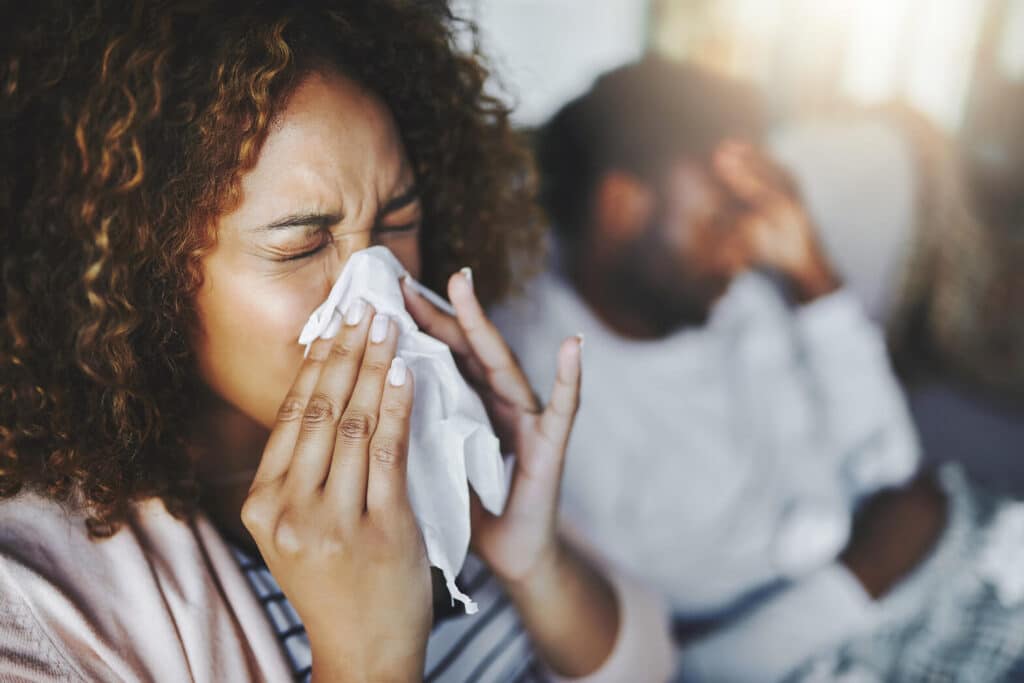Many travelers swear they get sick after every trip or holiday, and people are of the opinion that airplanes are plagued with bacteria and viruses. And they’re not wrong – planes and airports are filled with germs.
But you can reduce the chances of getting sick after flying. Here’s our guide to what causes post-flight flu, how to prevent it, and answer some pressing questions on post-flight flu symptoms, treatments, and more.

How Airplanes Can Make You Sick After Flying
Airline carriers are almost impressive carriers of the common cold. In fact, according to a study published in the Journal of Environmental Health Research, you may be 100 times as likely to catch a cold on a plane as in your normal day-to-day life.
The most likely culprit: extremely low cabin humidity. Most commercial airlines fly in an elevation range of 30,000 to 35,000 feet – this is where humidity runs at 10% or lower. And at low levels of humidity your body’s natural defense system of mucus in the nose and throat dries up, creating a much more tolerant environment for germs.
Add this to the fact that germs can survive for hours or days after the passenger who brought them on board has departed, and you have the recipe for post-flight flu. Besides the common cold and influenza, these bugs and viruses can cause everything from skin diseases and upset stomachs, with studies revealing that E. Coli can live on the plane for over a week.
Either way, you certainly run the risk of becoming sick on a flight from directly inhaling particles in the air from someone’s coughing or sneezing. You can also become sick if you touch an infected surface and then touch your eyes, mouth, or nasal passages.
The longer you are exposed to these things the more chance you have of getting ill. So, in theory, you are less likely to get sick after flying on shorter flights than long haul flights.

Understanding Post-Flight Flu Symptoms
After a flight, you might feel tired, congested, or even feverish. Here’s a closer look at the symptoms commonly experienced after flying:
- Fatigue and Weakness: Travel stress and disrupted sleep can lead to severe fatigue, often making people feel drained for days. Long-haul flights are particularly tiring, as they may include time zone changes that disrupt your internal clock and sleep cycle.
- Congestion or Runny Nose: As we said earlier, low level of humidity in airplane cabins dries out nasal passages, leaving them vulnerable to irritation and congestion. Exposure to recycled cabin air, which may carry allergens and microbes, can lead to sneezing or a runny nose shortly after landing.
- Sore Throat and Cough: With the cabin’s dry air, your throat can easily become scratchy or sore. If the irritation continues, it may lead to coughing, which can be confused with cold symptoms, though it’s more often a result of dehydration.
- Headache and Dizziness: Dehydration combined with low oxygen levels in the cabin air can lead to mild hypoxia, often causing headaches. These headaches may worsen with jet lag, particularly if you’re also fatigued.
If you experience any or all of these symptoms, it could be what’s known as the “post-flight flu.” They may resemble cold symptoms but are often more connected to travel-related conditions.
Is Post-Flight Flu Contagious?
The answer depends on what’s behind your symptoms. The term “post-flight flu” often describes symptoms brought on by factors such as dehydration, low humidity, and stress on your immune system due to flying.
If that’s the cause, then it’s not contagious, because the cause of your symptoms are environmental factors rather than a virus.
How Long Does Post-Flight Flu Last?
The duration varies based on factors like overall health, hydration levels, and immune system resilience. Typically, symptoms should improve within a few days to a week. If they persist or worsen, it could indicate a different illness, so consult a healthcare professional.
Want to know how to get rid of a cold in 24 hours or less? Click here.
How to Avoid Post-Flight Flu
When it comes to combatting airplane germs, there are some ways to reduce your chances of getting sick after flying.
1. Board The Airplane Last
Cramped airplane cabins are breeding grounds for airplane germs. In fact, the best way to avoid getting sick after flying might be avoiding the crowds and queues waiting to board the airplane and those standing in the cabin while other passengers find their seats and pack their luggage away. Researchers suggests you’re better off boarding the airplane last, or at least staying away from the initial hordes of people.
2. Keep Your Hands As Clean As Possible
Your hands come into contact with so many different surfaces – especially while flying. So, keeping them clean will help reduce your chances of picking up cold and flu germs at the airport or during your flight. If you actually pay attention to how often you touch your face during the day, you’ll realize how easy it is to bring germs into contact with your nose, mouth, and eyes.
Cold and flu germs can survive for hours on most surfaces, so just assume the surface is dirty and wash or sanitize your hands after touching it. Understandably, it’s not possible to wash your hands every single time you touch a surface, so at least aim to wash your hands after using the bathroom or before you eat something. Carry a hand sanitizer with you to keep your hands clean on the go.
3. Sanitize The Area Where You’re Sitting
Even though airplanes are sanitized by the crew before you embark, a little extra cleaning won’t hurt. Keep anti-bacterial sanitization wipes with you so you can clean your set, wipe down the tray table, arm rests, video monitor screen, etc.
4. Give Your System A Boost
Before you embark on your trip, try to increase your intake of nutrient-rich foods. Speak to your physician about a vitamin supplement. Even a simple vitamin C supplement is known to make a difference before traveling. Build up your immune system several days before your flight to give your body a better chance of fighting off those airplane germs.
5. Stay As Hydrated As Possible
Flying can be extremely dehydrating on its own but staying hydrated in the hours leading up to and during your flight will significantly benefit your immune system and help keep side effects like fatigue, cramps, and headaches at bay.
Your nose and throat are usually the first to feel the effects of dehydration, so increasing your water intake can prevent airplane germs from making you sick after your trip. You can also pick up a normal saline nasal spray from the pharmacy to keep your nasal passages from getting dry during your flight.
6. Keep Oral Hygiene In Mind
Many people forget how important dental hygiene is for warding off colds and flu. Your mouth carries germs too. A good mouth wash will keep your throat moist, but an anti-bacterial mouth wash can also provide you with some added protection during your flight. Most pharmacies stock travel-sized mouth washes that you can keep in your carry-on luggage.
7. Use The Overhead Vent To Your Advantage
Keep your seat’s overhead vent on to keep germs away from your face. To get the vent at the right angle, place your hands in your lap and make sure the air is hitting your hands. Unfortunately, it might not be realistic to keep this on throughout your flight, so the added protection of wearing a face mask during your flight is a good idea to keep airplane germs from making you sick.
Treatment For Post-Flight Flu
While there’s no magic cure for the “post-flight flu,” several treatments can help ease symptoms and speed up recovery. Here are some effective methods to help you get back to feeling your best:
- Prioritize Rest and Sleep: Flying takes a toll on your body, especially if you’ve been through a long-haul flight with disrupted sleep or a significant time zone change. Allow yourself extra time to rest, as quality sleep helps your immune system recover and combat any germs you might have been exposed to during the flight.
- Hydrate, Hydrate, Hydrate: Airplane cabins are notoriously dehydrating. Replenishing lost fluids is crucial for easing congestion, relieving dry skin, and preventing headaches. Water is the best option, but electrolyte drinks can help you recover faster if you’re feeling especially fatigued or dehydrated.
- Use Over-the-Counter Remedies:
- Nasal Sprays: Saline nasal sprays can keep your nasal passages moist and relieve congestion caused by the dry cabin air.
- Throat Lozenges and Cough Drops: These soothe a scratchy throat and ease mild coughs that might develop from the dry air.
- Pain Relievers: For headaches, body aches, or mild fevers, common over-the-counter pain relievers like acetaminophen or ibuprofen can help alleviate discomfort. Always use them as directed.
- Try Steam or Use a Humidifier: To relieve dryness in your nose and throat, consider inhaling steam or using a humidifier. For steam inhalation, you can pour hot water into a bowl, lean over it with a towel covering your head, and breathe in the steam for 5-10 minutes. This helps moisturize your airways, making it easier to breathe and easing congestion. A humidifier in your room also provides similar relief by adding moisture back into the air.
- Avoid Caffeine and Alcohol: Both caffeine and alcohol are dehydrating, which can worsen symptoms like headaches and fatigue. Instead, focus on hydrating beverages like water, herbal teas, or electrolyte-rich drinks to help speed up recovery.
- Vitamin C and Immune-Boosting Foods: While not a cure, foods rich in vitamin C (such as oranges, berries, and leafy greens) can support your immune system as it recovers. You might also consider foods with anti-inflammatory properties like ginger, garlic, and turmeric, which help reduce congestion and support overall wellness.
- Use Essential Oils (If You’re Comfortable with Them): Essential oils like eucalyptus or peppermint can be helpful for opening up your nasal passages and relieving mild congestion. Add a few drops to a tissue and inhale, or use a diffuser to spread the aroma in your room. Be mindful, though—some people may be sensitive to these scents, so use them sparingly.
Post-flight flu can be frustrating, but with proper care and rest, symptoms usually ease up within a few days. If your symptoms persist longer than a week or worsen over time, it may be a sign of an infection or another condition that requires medical attention. In such cases, seeing a doctor is always a good idea to ensure you’re on the road to recovery.
If you’re traveling and need access to healthcare, the Air Doctor app can make finding medical assistance easy and stress-free.
About the Air Doctor App
Air Doctor is an easy-to-use app that connects you with a global network of multi-lingual doctors and specialists so you can access medical care anywhere, anytime. With the Air Doctor app in your pocket, you can access medical care and receive expert medical guidance wherever you are in the world.
Air Doctor offers a wide range of benefits, including:
- A global network of over 20,000 multi-lingual doctors and specialists
- Choice of clinic, at-home (hotel), and video consultations
- Active in 78 countries
- 24/7 multi-lingual support
- Transparent pricing and reviews
- Most common medical specialties, including pediatricians
If you’re looking for reliable, accessible, and global medical assistance, Air Doctor is the perfect choice for you. Download the app before your next trip to ensure peace of mind and access to quality healthcare, wherever your travels take you.












